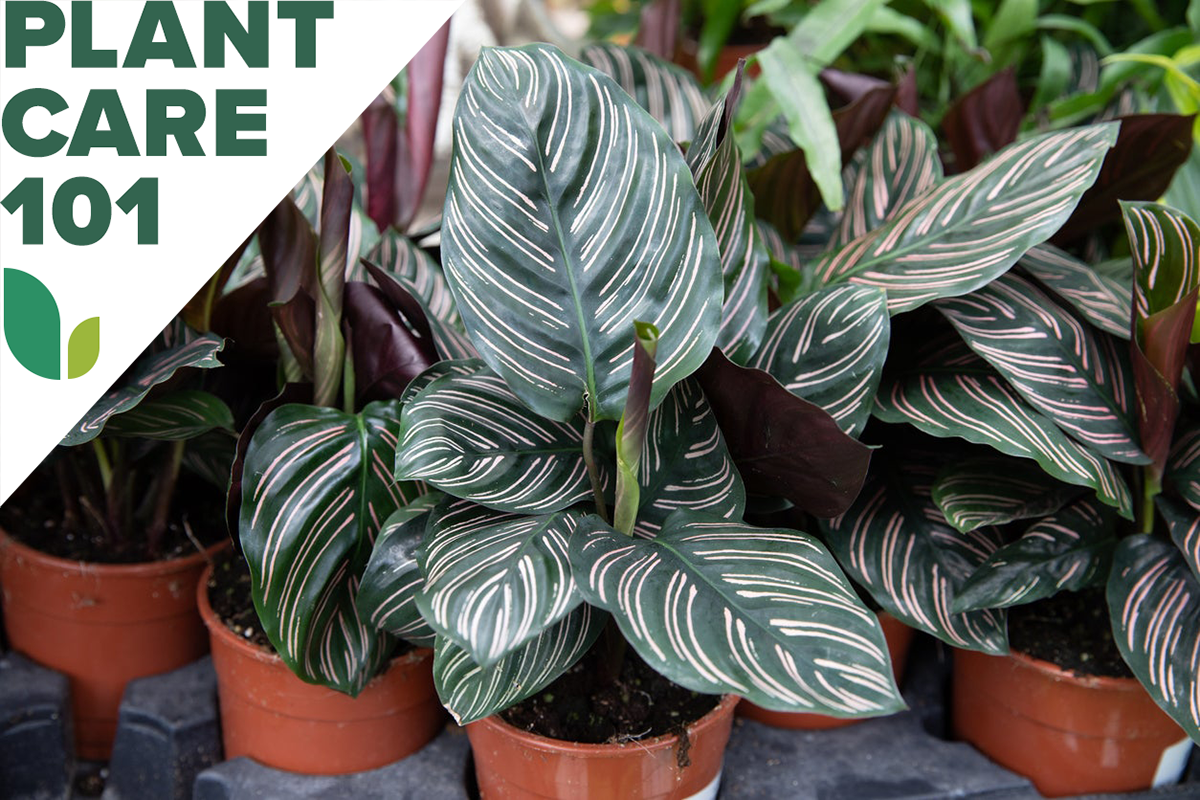

We may earn revenue from the products available on this page and participate in affiliate programs. Learn More ›
The calathea family comprises more than 300 cultivars, dozens of which are highly sought after as houseplants. Many calathea types boast bold, contrasting leaf veining that draws the eye and creates a natural focal point in the room. They’re also nontoxic to humans and animals, which certainly contributes to their popularity.
While a healthy prayer plant is stunning, it can be challenging to grow unless it receives the right light, water, and nutrients. Ahead, learn how to care for calathea and get this beautiful plant to thrive.
Calathea Care at a Glance
- Common Name: Pinstripe plant, rattlesnake plant, prayer plant
- Scientific Name: Calathea, subspecies of the Marantaceae plant family
- Soil: Well-draining, acidic (5.5-6.5 pH)
- Light: Partial or deep shade
- Water: As needed to maintain moist soil
- Food: Balanced (NPK 10-10-10) all-purpose fertilizer
- Temperature and Humidity: Warm, humid environment
- Propagation: Root division
- Safety: Nontoxic
Calathea Characteristics
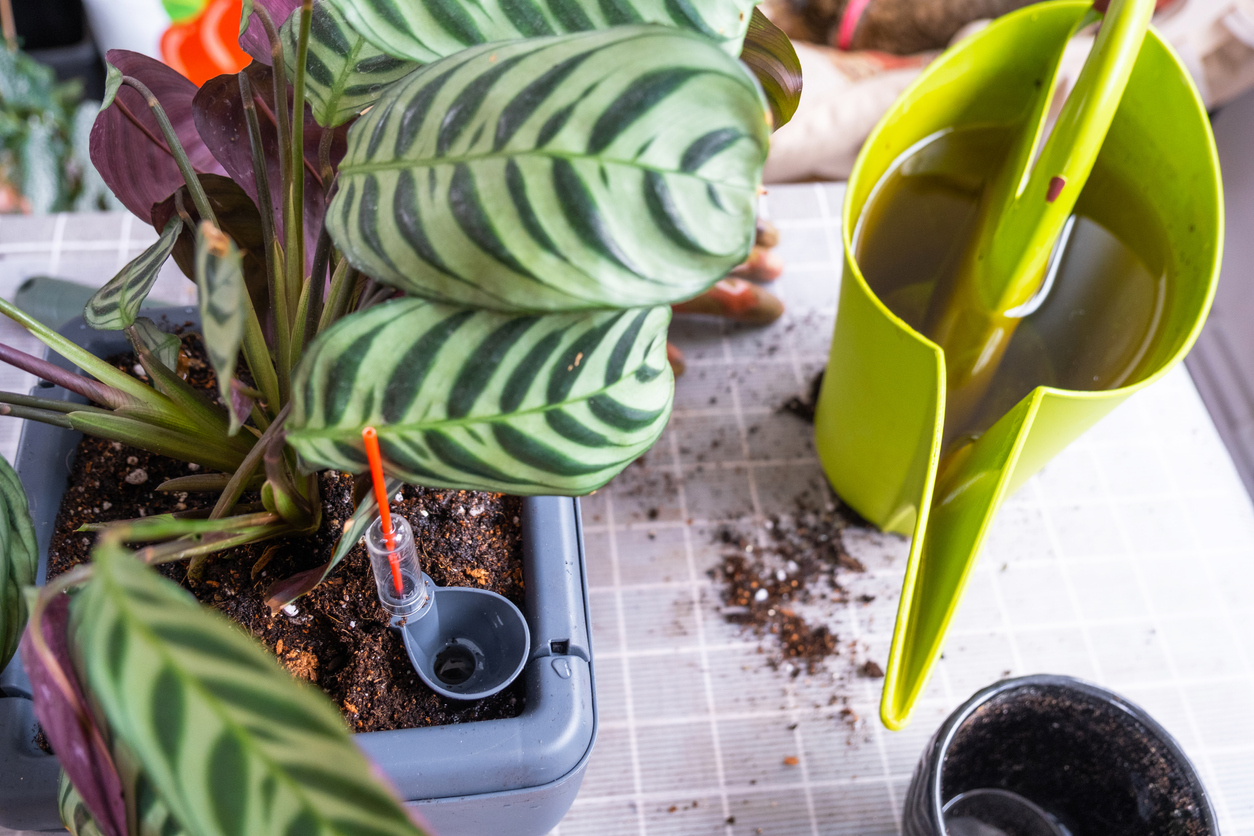
Among the most exotic of all houseplants, prayer plant is sought out for its bright contrasting colors and spectacular leaf designs, which vary widely by species. Calathea plants are native to Brazil, and they’re sometimes called the “prayer plant” because they draw their leaves upward at night, an unusual natural process called nyctinasty. Most varieties are also relatively small, ranging in mature height from just 6 inches up to 3 feet, so this species is especially well suited to rooms where space is limited.
While some calatheas bloom in their natural habitat, they’re not considered flowering plants when kept as houseplants, so don’t expect blossoms.
How to Care for Calathea
Calathea plants can be challenging to grow but as long as you provide the right conditions, they’ll easily thrive.
Select Soil for Calathea
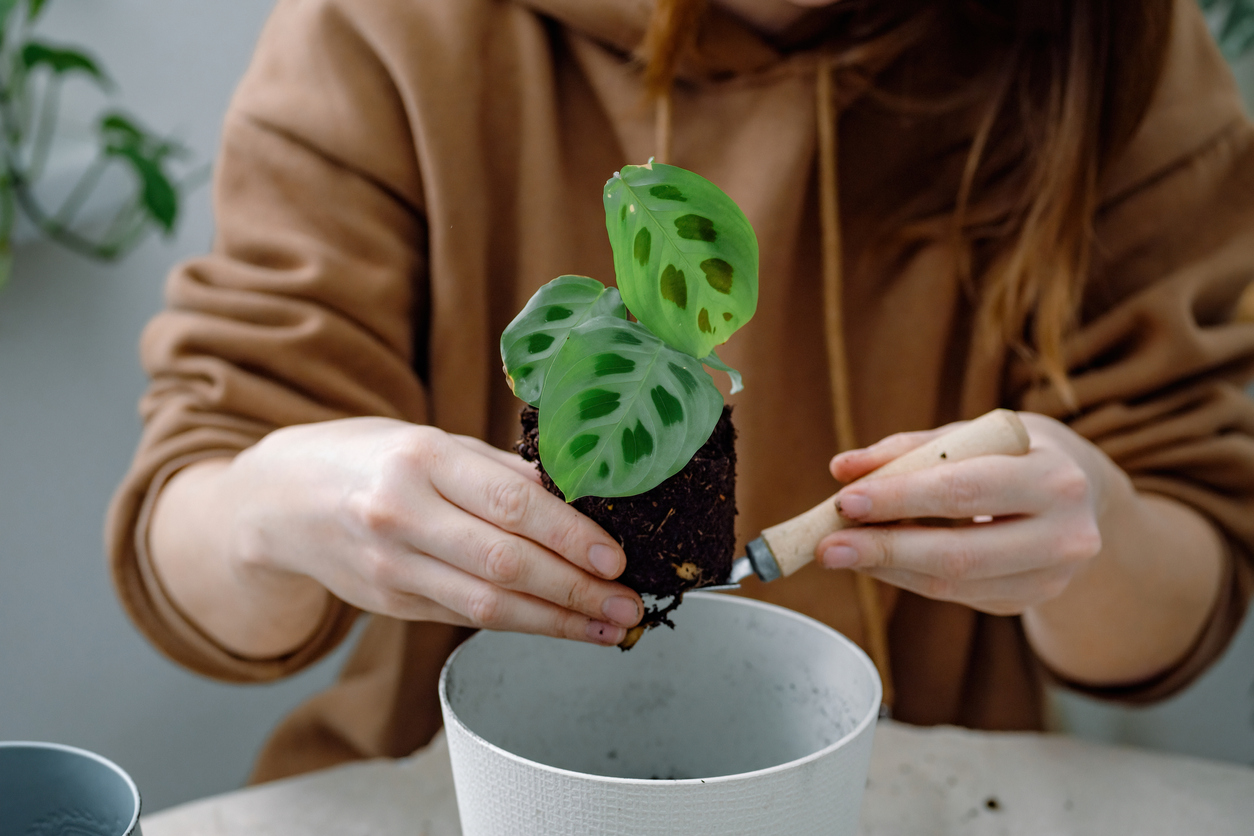
Use a commercial potting mix containing coconut coir or charcoal; both allow water to drain yet absorb enough to stay moist so calathea roots won’t dry out. Consider Miracle-Gro’s Indoor Potting Mix, which will provide a light, well-draining soil for this plant.
Alternatively, you can create your own growing mix by combining 50 percent sterile potting soil, 20 percent charcoal, 20 percent orchid bark, and 10 percent perlite.
When potting calathea, consider using a plastic pot or a glazed ceramic pot rather than an unglazed clay or terra-cotta pot. The unglazed types can wick moisture out of the soil, leaving it too dry for calathea’s tastes.
Choose the Right Light
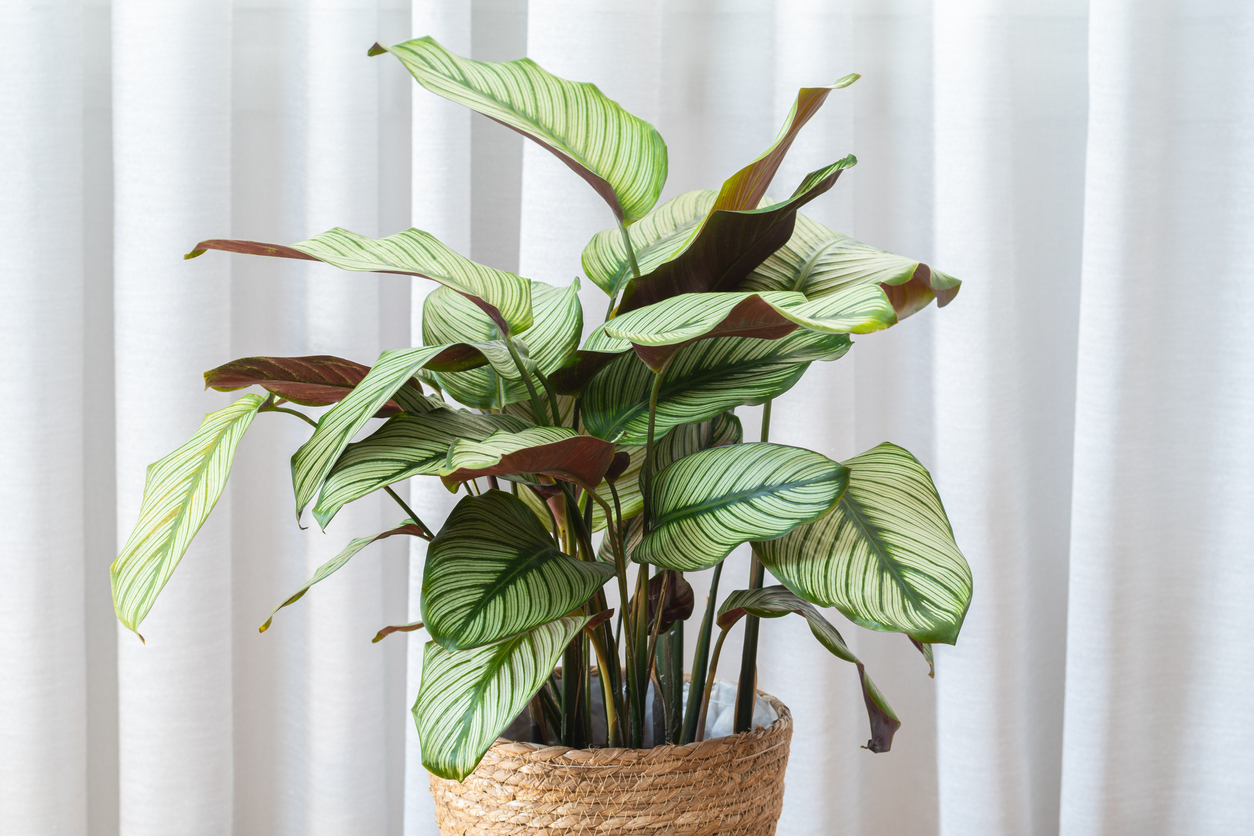
In its natural habitat, calathea grows on the subtropical jungle floor where the sun never shines. In the home, calathea do best with indirect light, such as near a north-facing window or even across the room from a window.
Calathea plants should never receive direct sunlight since it will burn their leaves, causing them to curl, turn brown, and fall off. It can even kill the plant. Calathea types that feature rose or purple coloring will benefit from medium indirect light rather than deep shade to fully develop their bold color.
Water Your Calathea
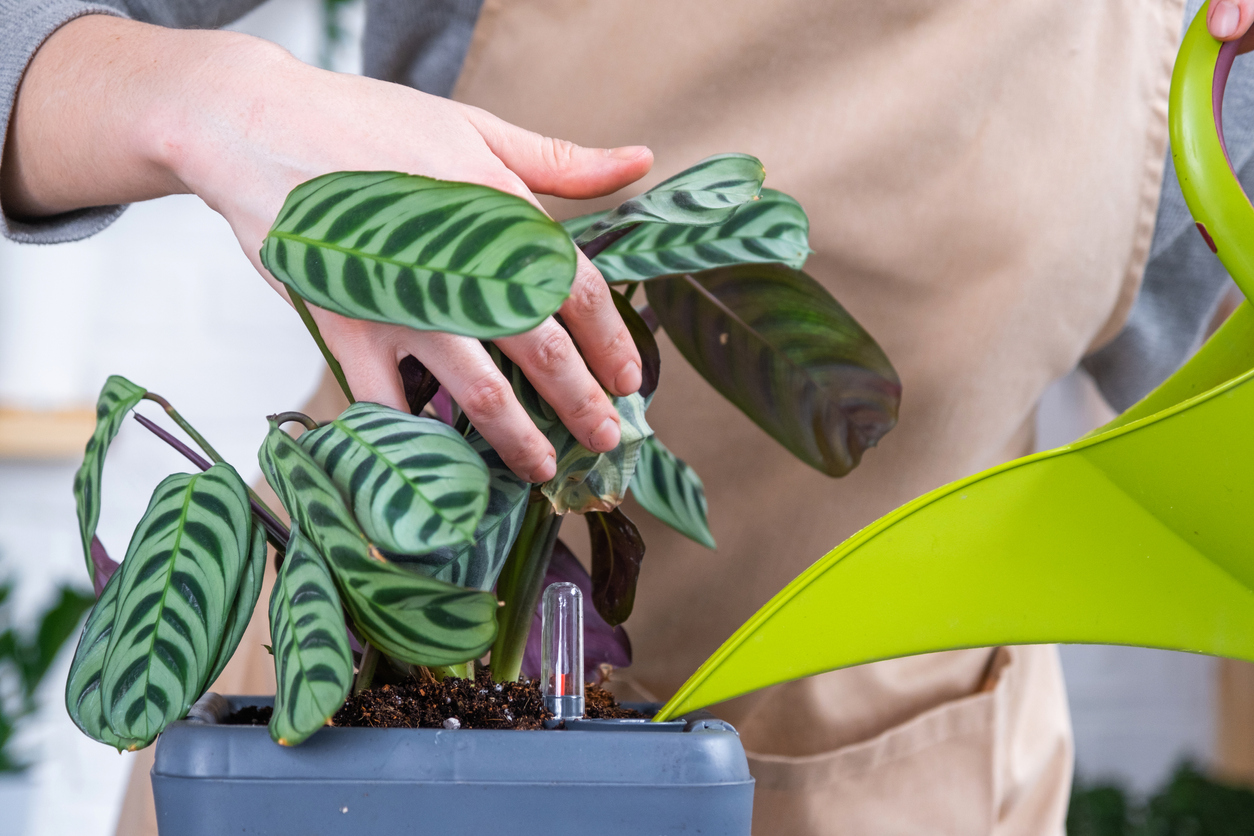
Tap water might contain too many minerals or contaminants that can stunt this plant’s growth, so only use distilled water, if possible. Start by watering the plant thoroughly until the water stops draining out the bottom (setting it in a sink for this step is optimal). Then check the soil in two days, then every day after. When you poke a finger 2 inches into the soil, it should come out wet, but the soil should not feel soggy.
Calathea roots like moist soil, which means the plant must receive water frequently enough to keep the soil moist at root level. But they don’t like sitting in soggy soil, so the soil must drain well. Always plant calathea in a pot with drainage holes.
Fertilize Your Calathea
A balanced indoor plant fertilizer with a 10-10-10 NPK ratio (nitrogen, phosphorus, potassium) is well-suited for keeping calathea healthy. During fall and winter, reduce fertilizing to once every three months. To avoid over fertilizing, consider keeping a log of each time you feed the plant. A commercial fertilizer, such as Bonide’s Liquid Plant Food, works well for fertilizing most calathea types.
Subtropical calathea benefit from monthly feedings during its high-growth seasons of spring and summer, but don’t fertilize more frequently.
Set the Temperature and Humidity
Calathea houseplants prefer temps between 70 and 85 degrees Fahrenheit. Don’t keep them in rooms where the temperature drops below 60 degrees Fahrenheit. Since most homes are kept warmer than this, temperature usually isn’t a big concern when growing calathea indoors.
However, calathea plants like a humid environment, so mist the plant with water once or twice a day or run a humidifier in the room. Alternatively, try growing calathea in a large terrarium, such as the H Potter Glass Terrarium, which provides uniform high humidity. You can also grow it in a fairly humid room, such as a bathroom. Steamy showers will provide the humidity this plant loves.
Prune Your Calathea
Use clean shears or scissors to remove any damaged or yellow leaves, cutting close to the base where the leaf emerges from the stem. You can also trim any leggy stems back to the desired height, cutting just above the leaf node. If your calathea plant has flowers, cut off the entire flower stalk at the base once the flowers are spent so the plant can focus on foliage growth.
It’s best to prune calathea plants during their growing season in the spring or summer because it allows the plant to recover from the pruning faster.
Calathea Propagation
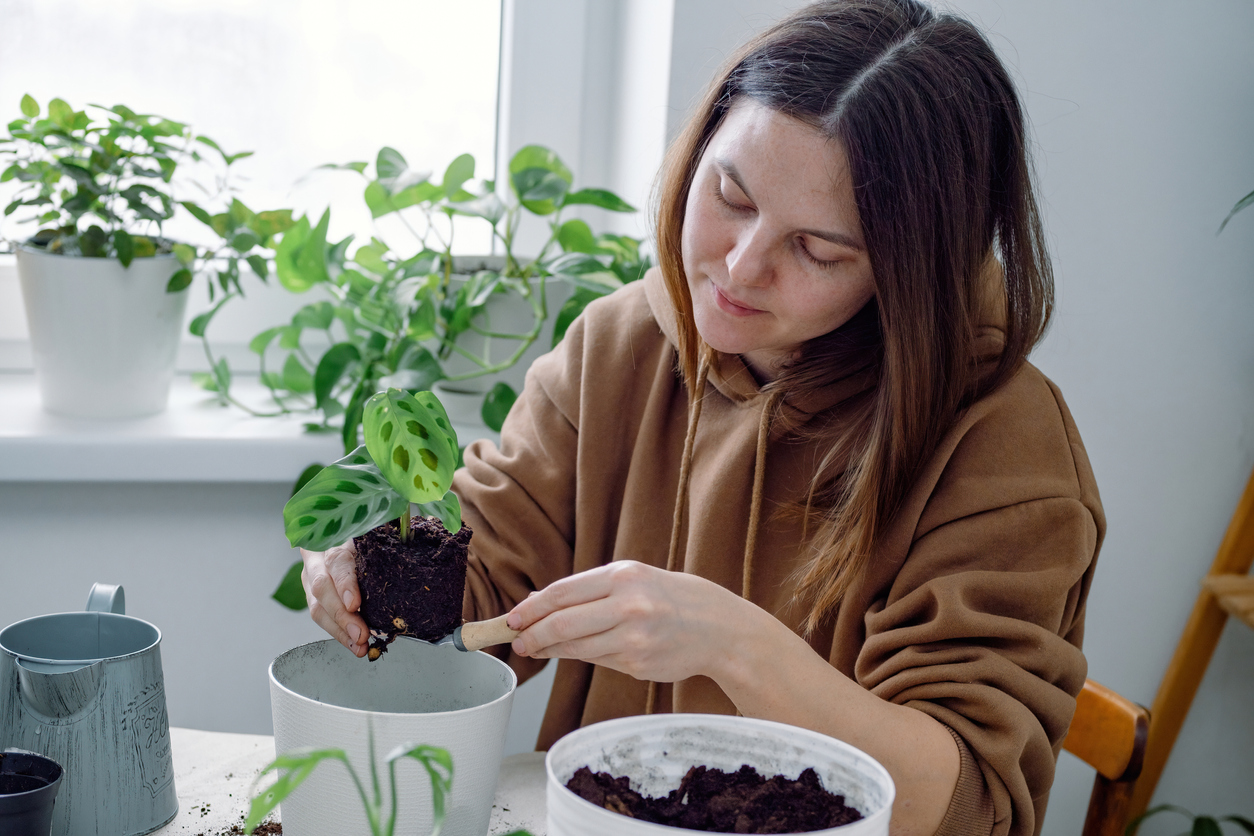
Calathea is one of a few houseplants that cannot be propagated by taking cuttings and rooting them in water. Instead, it can be reproduced by division. The best time to try propagating a new calathea plant is when you’re transplanting a mature plant to a larger pot. Here’s how to do it:
- Remove the calathea from its existing pot.
- Work your fingers gently between the shoots at the base and carefully separate a few shoots (and roots) from the rest of the plant.
- Plant the new shoots in their own pot at the same time you repot the mature plant.
- Water and fertilize the new plant as you would the adult plant and watch your new calathea grow.
Types of Calathea

There are many calathea types. Here are some of the more popular calathea plants you’ll find in nurseries.
- C. dottie: Characterized by its tricolored leaves that feature green, dark purple, and bright pink veining, dottie reaches a mature height of 1 foot.
- C. concinna: Reaching a mature height of 1.5 feet, this calathea boasts light green, elongated oval leaves with contrasting deep green stripes.
- C. orbifolia: One of the taller calathea types, C. orbifolia can reach up to 2 feet high at maturity and is prized for its large round, glossy leaves with deep green stripes.
- C. roseopicta: Also called “rose-painted calathea,” this calathea type features elliptical leaves that start out green with deep rose centers that eventually turn white.
- C. ornata: Known as the “pinstripe plant,” this is a tall calathea type, reaching 3 feet high at maturity, with striking oval leaves that have narrow pink-ish stripes.
- C. makoyana: Also called the “peacock plant,” this calathea type features pale green leaves with a dark green feathered pattern. It’s usually 1 to 2 feet tall at maturity.
- C. lancifolia: Often referred to as the “rattlesnake plant,” this calathea has long wavy leaves that feature a dark green snake-like pattern on top and a deep purple underside. It can reach 3 feet at maturity.
- C. medallion: This calathea type features oval, patterned leaves with a mix of dark green and white hues, and it’s usually 1 to 2 feet tall at maturity.
- C. crocata: Dubbed the “eternal flame” thanks to its bright yellow-orange flowers, c. crocata plants grow up to 2 feet tall and feature dark green glossy leaves.
- C. zebrina: Commonly called the “zebra plant” for its dark green leaves with zebra-like stripes, this calathea type can reach up to 3 feet at maturity.
Potential Pests and Diseases
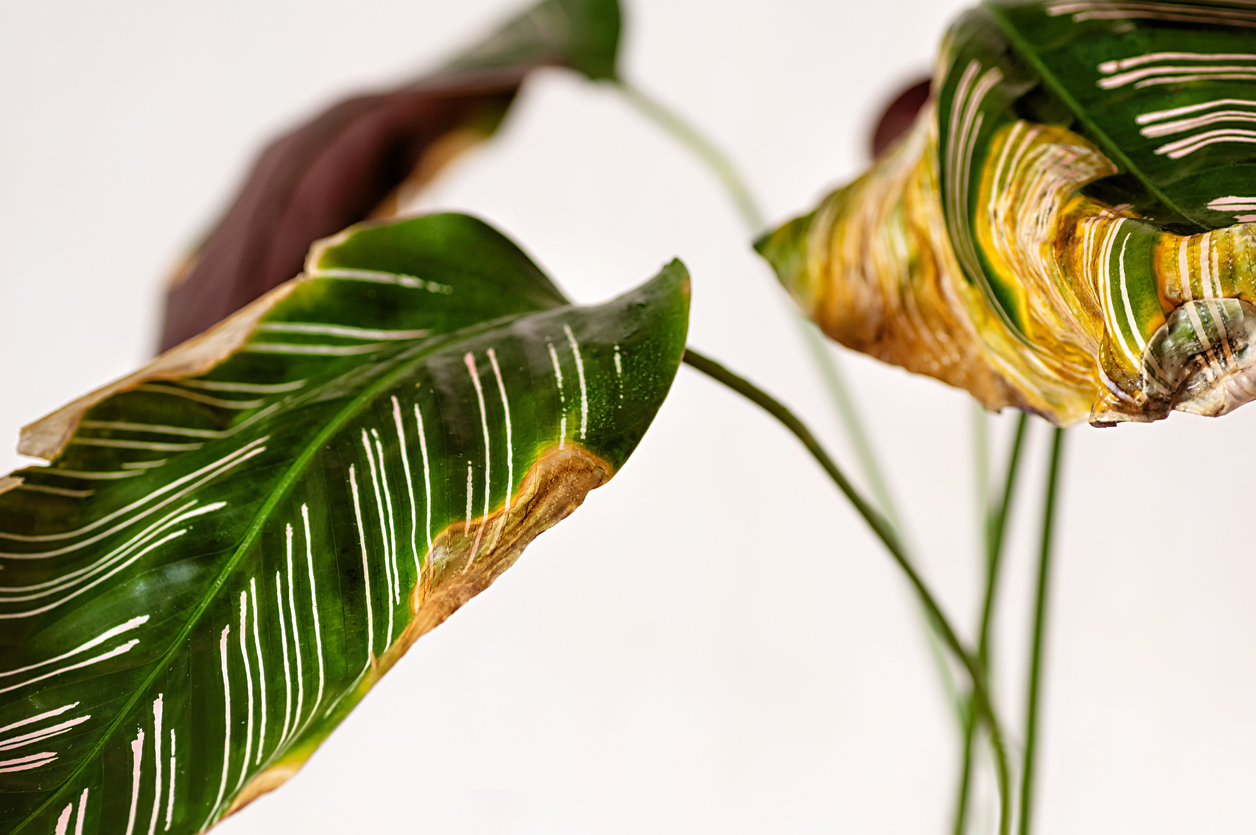
Fortunately, calathea is typically pest-free and isn’t highly susceptible to any particular type of insect infestation. That doesn’t mean it won’t play host to insects already in the home, such as gnats, mites, or whiteflies. You can remedy most pest problems quickly by applying a natural pesticide, such as neem oil.
Calathea is more likely to develop a fungal disease from over-watering, appearing as spots on the leaves. Treat fungus promptly by spraying a fungicide that’s suitable for use on houseplants, such as Garden Safe Fungicide 3. If fungus occurs repeatedly, it might be time to repot the plant with a better-draining soil mix or reduce watering frequency.
FAQs

Q: How can I save a dying calathea plant?
If over-watering has led to root rot, it might not be possible to save the plant. If calathea is drooping or wilted due to under-watering, however, repotting it in a well-draining soil and following a regular watering routine might revive it.
Q: Why are my calathea leaves curling?
Water problems primarily cause calathea leaves to curl. Overwatering, underwatering, and low humidity can all cause the leaves to curl. However, hard water, too much sunlight, and spider mite infestations can also lead to curling leaves.
Q: Are calathea plants toxic to cats and dogs?
No, calathea plants are not toxic to cats, dogs, or other animals.
Q: Why is my calathea drooping?
Calathea plants typically droop because they’re thirsty, so adding water usually revives them. However, they can also droop due to root rot from overwatering or from being placed in a room that’s too chilly.
